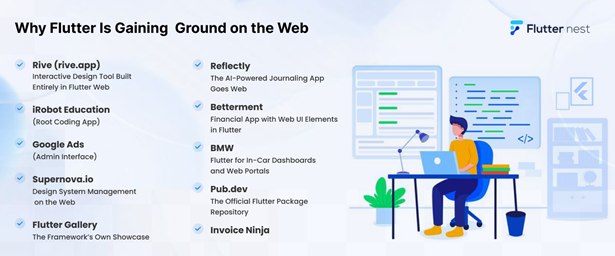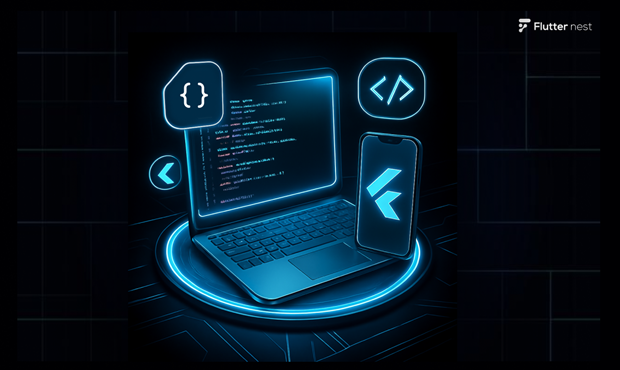Flutter has quickly evolved from a mobile-first framework to a cross-platform powerhouse. Today, it’s powering not just Android and iOS apps, but also full-fledged web applications used by millions globally. From enterprise dashboards to design tools and education platforms, the list of apps built with Flutter is growing—and not just on phones.
In this blog, we explore real-world Flutter app examples that have made their mark on the web. These are not MVPs or hobby projects—they are production-grade, widely used platforms that showcase what’s possible when Flutter is used right.
Whether you’re a startup founder, a CTO, or a frontend engineer exploring modern stacks, these famous apps in Flutter reveal lessons worth noting.
As Flutter continues to evolve, flutter web app development is becoming a significant focus for businesses looking to create seamless, cross-platform applications.
Why Flutter Is Gaining Ground on the Web
Before the examples, it’s worth quickly recapping why Flutter has become an attractive option for building apps across mobile and web:
- Single Codebase: One Dart codebase can run on Android, iOS, and the browser—drastically reducing development time and cost.
- Native-like Performance: With Skia, Flutter renders UIs directly, giving it a performance edge even on web compared to some traditional JavaScript frameworks.
- Design Consistency: UI elements look and behave the same across platforms, making brand consistency easier to maintain.
- Strong Ecosystem: Integration with Firebase, REST APIs, WebSockets, GraphQL, and other modern web tools is seamless.
Now let’s see these strengths in action through real apps.

1. Rive (rive.app) — Interactive Design Tool Built Entirely in Flutter Web
Category: Design & Animation Tool
Used Flutter For: Entire browser-based app
What It Does
Rive is a cutting-edge design and animation tool for building interactive graphics, motion, and animations. What makes it stand out? It’s entirely built on Flutter for web.
Why It’s Impressive
- Real-time rendering of animations directly in the browser
- No plugins or downloads required
- High-performance canvas interactions, thanks to Flutter’s Skia engine
What You Can Learn
Flutter can be used to build heavy UI/UX creative tools—traditionally dominated by desktop apps or WebGL-heavy frameworks. If you’re building a product that involves complex rendering, Flutter web can handle it.
2. iRobot Education (Root Coding App)
Category: EdTech / Robotics
Used Flutter For: Cross-platform learning interface
What It Does
iRobot’s Root Coding app lets kids program virtual and physical robots using visual coding blocks and Swift. While it was initially mobile-focused, it now runs in the browser—thanks to Flutter Web.
Why It’s a Strong Example
- The entire codebase is shared across web, iOS, and Android
- Handles real-time feedback and simulated environments
- Combines education with gamification without performance issues
What You Can Learn
Apps in Flutter aren’t limited to CRUD dashboards. You can build educational platforms with real-time interactivity and device communication—all in the browser.
3. Google Ads (Admin Interface)
Category: Enterprise Marketing Dashboard
Used Flutter For: Internal admin interface for web + mobile
What It Does
Yes, Google uses Flutter for its own products. The internal Google Ads platform, used by account managers, is built using Flutter and deployed across web and mobile.
Why It’s Noteworthy
- High volume of data visualization, charts, and interactions
- Enterprise-grade security and performance demands
- Developed and maintained by Google’s own teams
What You Can Learn
If Google can manage enterprise workflows and cross-platform consistency with Flutter, so can you. It validates Flutter’s capability for complex, large-scale, Flutter web apps.
4. Supernova.io — Design System Management on the Web
Category: SaaS / DesignOps
Used Flutter For: Entire web application frontend
What It Does
Supernova lets teams convert Figma designs into design systems and production-ready code. Its dashboard and collaboration tools are built using Flutter for web.
Highlights
- Integrates tightly with Figma
- Real-time UI updates when changes are made
- Allows team collaboration and versioning within the app
What You Can Learn
Building apps in Flutter for B2B SaaS? Absolutely possible. Supernova proves Flutter can power design-heavy, collaborative SaaS platforms that run reliably in the browser.
5. Flutter Gallery — The Framework’s Own Showcase
Category: Developer Resource
Used Flutter For: Live demo of Flutter widgets, layouts, and performance
What It Does
Flutter Gallery is the official interactive showcase of Flutter widgets and capabilities. And it’s available as a full-fledged web experience.
Key Features
- Interactive widget previews
- Performance benchmarking
- Educational samples of best practices
What You Can Learn
Want to test Flutter’s web capabilities yourself? Start here. This is a ready-made demonstration of the framework’s responsiveness, accessibility, and rendering on the web.
6. Reflectly — The AI-Powered Journaling App Goes Web
Category: Wellness / Lifestyle
Used Flutter For: Mobile and web journaling interface
What It Does
Reflectly is a journaling app powered by AI that helps users reflect on their day and boost mindfulness. While it started on mobile, the team ported the same interface to the web using Flutter—bringing cross-device continuity to user experiences.
Why It’s Noteworthy
- Seamless experience across Android, iOS, and browser
- Rich UI with animations, gradients, and cards—fully retained on web
- AI-powered journaling logic runs identically across platforms
What You Can Learn
Apps built with Flutter like Reflectly show that web UX doesn’t need to be a stripped-down version of mobile. A strong design language and user interactions can be preserved across screen types—without rebuilding from scratch.
7. Betterment — Financial App with Web UI Elements in Flutter
Category: FinTech
Used Flutter For: Dashboard components and onboarding flows
What It Does
Betterment is a well-known investment and robo-advisory platform. While its backend and core finance systems are custom, several frontend UI flows—especially in the onboarding and account settings—have been rebuilt using Flutter for the web and mobile.
Why It Matters
- The modular Flutter widgets allowed consistent UX across investment workflows
- Teams reused logic between mobile and browser
- Flutter’s web responsiveness was key to adapting layouts for desktop users
What You Can Learn
Even if you’re not building 100% in Flutter, integrating Flutter app examples like Betterment shows you can gradually adopt the framework—starting with isolated modules or new features. A hybrid approach can accelerate modernization.
8. BMW — Flutter for In-Car Dashboards and Web Portals
Category: Automotive / IoT
Used Flutter For: Infotainment UI + web fleet management tools
What It Does
BMW Group adopted Flutter to build its next-generation infotainment systems. While the primary use is in-car, the ecosystem also includes a web portal for fleet and account management—built using Flutter Web.
Key Highlights
- Consistent UI in cars and on web dashboards
- Integration with real-time data, maps, and vehicle status
- Same design system across embedded and web apps
What You Can Learn
Famous apps in Flutter aren’t just consumer-facing. Enterprise tools, automotive interfaces, and connected web portals are a major area of growth. Flutter lets you control the user experience end-to-end—from devices to dashboards.
9. Pub.dev — The Official Flutter Package Repository
Category: Developer Tools / Web Platform
Used Flutter For: Entire frontend interface
What It Does
Pub.dev is the official home for Dart and Flutter packages. It’s the go-to registry for developers working with the framework—and yes, it’s fully built with Flutter Web.
Why It’s Interesting
- Thousands of developers use it daily
- Search, filters, package scores, and version history are interactive
- Uses Flutter to manage fast loading, transitions, and scalable UI
What You Can Learn
When a framework is used to build and run its own core tools (eating your own dog food, as they say), it’s a signal of confidence. If Flutter is performant and flexible enough for its own package management portal, it’s ready for your next web project too.
10. Invoice Ninja
Category: SaaS / Business Tools
Used Flutter For: Entire invoice management system (mobile + web)
What It Does
Invoice Ninja is a robust invoicing and client management solution for freelancers and small businesses. It’s built entirely using Flutter—for mobile, desktop, and web platforms.
Key Features
- Recurring invoicing, expense tracking, and time tracking
- Responsive dashboards and PDF previews on web
- Offline sync between devices
What You Can Learn
Apps in Flutter like Invoice Ninja show the power of unified business tools. You can ship a rich, cross-platform SaaS product with feature parity across environments—without bloating your team or tech stack.
Key Patterns From These Success Stories
Looking across these Flutter app examples, some clear patterns emerge. These can act as guideposts for your own product planning and development:
1. Consistency Drives Loyalty
Whether it’s Reflectly’s journaling UI or iRobot’s educational canvas, users appreciate when the experience feels identical across their devices. Flutter enables this without duplicating work.
2. Start Modular, Then Expand
Betterment and BMW show that you don’t need to go all-in on day one. Flutter works well in hybrid setups, letting you start with key flows or components and gradually expand.
3. Performance Scales With Complexity
From data dashboards to real-time animation editors, these examples prove that apps built with Flutter can go beyond simple forms and buttons. Whether it’s charts, canvas, or 60fps transitions—Flutter holds up, delivering excellent Flutter app performance even in complex scenarios.
4. Design and Brand Consistency Matters
Tools like Supernova, Rive, and Reflectly demonstrate how Flutter allows intricate UI design systems to be fully respected—even on the browser.
5. Developer Experience Is a Hidden Win
Teams building with Flutter often cite hot reload, widget libraries, and native rendering as major boosts to speed and productivity. This shortens your product cycles significantly.
Thinking Ahead: Should You Use Flutter for Your Web App?
The examples above are more than just case studies. They’re a reflection of Flutter’s maturity and flexibility as a front-end framework in 2025 and beyond. Whether you’re building a SaaS dashboard, a wellness tool, a learning platform, or even a fintech product, the framework can:
- Reduce engineering costs by reusing code
- Accelerate design-to-release timelines
- Maintain high UI/UX standards across platforms
- Power real-time, interactive, and data-driven experiences
For an in-depth view of where Flutter for web stands today, you can explore this detailed guide on Flutter web app development.
Final Takeaways
The growing list of apps built with Flutter—from global giants like BMW and Betterment to innovative platforms like Rive and Reflectly—signals a significant shift in the tech landscape. Businesses no longer treat the web as a separate domain; instead, they demand consistency, performance, and a polished experience across both mobile and desktop platforms. Flutter delivers on these expectations with impressive results.
As we at Flutternest continue to leverage Flutter’s capabilities, it’s clear that the framework is not just for mobile anymore. Whether you’re building the next generation of collaborative tools, launching a wellness platform, or modernizing enterprise portals, Flutter provides the scalability and flexibility to create rich, engaging user experiences across all platforms.
In this new era of cross-platform development, Flutter is emerging as a powerhouse—empowering businesses to bring their ideas to life faster while maintaining top-tier performance and visual appeal. With its strong ecosystem, growing community, and endless potential, Flutter is not just the future of mobile development; it’s a game-changer for the entire web and beyond.

